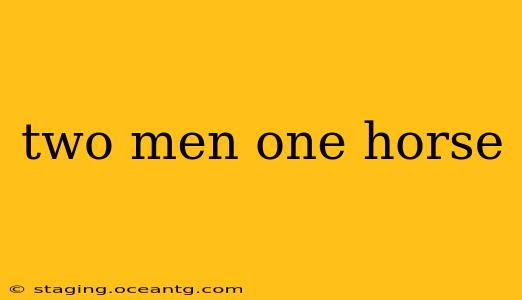The classic riddle "Two men, one horse" isn't just a brain teaser; it's a microcosm of economic principles, illustrating concepts like resource allocation, negotiation, and the inherent challenges of scarcity. This seemingly simple scenario highlights the complexities of dividing limited resources among competing interests, a problem relevant from personal finance to international trade. Let's delve into the puzzle and its surprisingly profound implications.
The basic premise usually goes something like this: two men need to travel a certain distance, and they only have one horse. How do they manage the journey? The answer isn't as straightforward as you might think. There's no single "correct" solution; instead, the puzzle sparks discussion about several potential approaches and their inherent trade-offs.
How Can Two Men Share One Horse?
The most obvious solution involves taking turns. One man rides the horse partway, then dismounts and lets the other man ride. This is a simple, practical approach, but it significantly increases the overall travel time. The efficiency is low, and it assumes both men are equally capable of walking and riding.
What if the Distance is Long?
This significantly changes the dynamic. If the distance is substantial, the alternating riding and walking method becomes impractical. Fatigue, time constraints, and the varying stamina of the two individuals all become significant factors. Perhaps one man is significantly stronger or more experienced in riding, leading to a more efficient approach where that individual rides for a longer portion of the journey.
What are the Different Solutions?
There are a few different solutions that can be considered, depending on the context:
- Alternating riding and walking: The simplest solution, but the least efficient in terms of time.
- One man rides, one man walks: More efficient if one man is significantly fitter or has a higher riding skill.
- Carrying the horse part of the way: This is feasible for short distances, or for a very light horse, but impractical for longer distances and heavier animals.
- Finding alternative transportation: While outside the initial constraints of the problem, this is a perfectly valid solution if resources allow.
The optimal solution depends entirely on the specific context: distance, terrain, and the capabilities of the two men.
What Economic Principles Does This Illustrate?
The "Two Men, One Horse" problem provides a simple yet effective illustration of several core economic principles:
- Scarcity: The limited availability of the horse highlights the fundamental economic problem of scarcity – unlimited wants and needs with limited resources.
- Opportunity Cost: Every choice has an opportunity cost. Choosing to ride the horse means sacrificing the time it takes to walk. Choosing to walk means sacrificing the speed of riding.
- Resource Allocation: The puzzle forces us to consider how to best allocate the limited resource (the horse) to achieve the desired outcome (reaching the destination).
- Negotiation and Bargaining: In a real-world scenario, the two men would likely need to negotiate and compromise to reach an agreement on how to share the horse.
What About Modern Interpretations?
The riddle's enduring relevance lies in its applicability to modern economic challenges. Think of it as a metaphor for:
- Shared resources: Consider competing businesses vying for limited market share, or nations negotiating access to limited natural resources.
- Efficient use of technology: The horse represents a scarce resource, while efficient allocation reflects the optimal use of technology or infrastructure.
The "Two Men, One Horse" puzzle is more than just a whimsical question; it's a powerful, succinct example of fundamental economic principles that continue to shape our world. It reminds us that effective resource management often requires careful consideration, compromise, and an understanding of the trade-offs involved.
